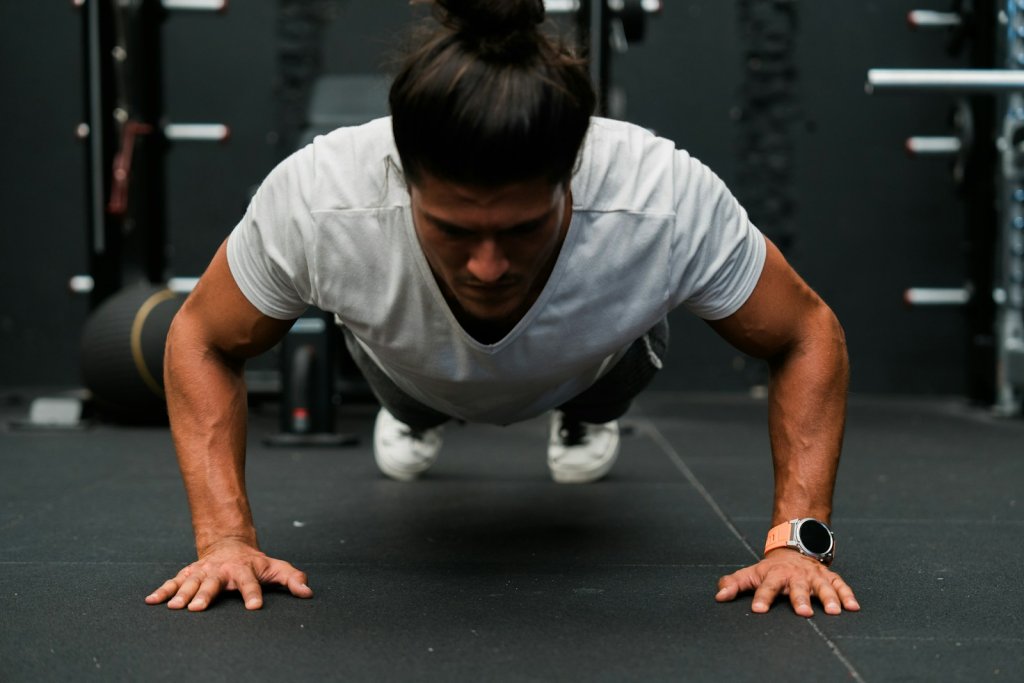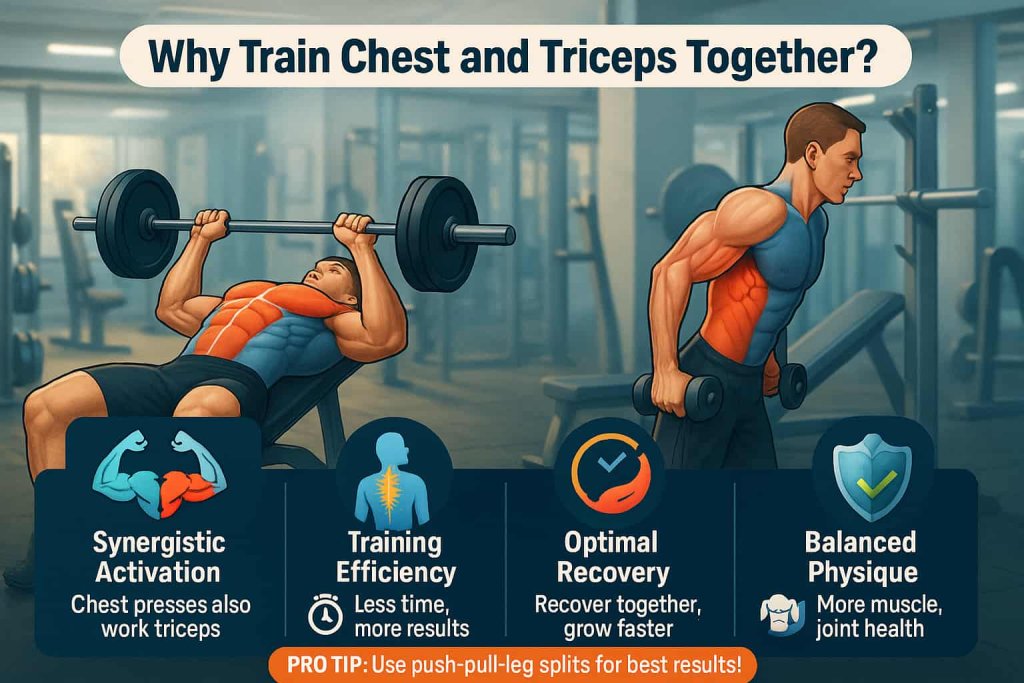The best chest and triceps workouts blend heavy compound presses with targeted isolation exercises to maximize muscle growth, strength, and definition—backed by the latest scientific research and leading trainers. In this guide, you’ll discover the most effective movements for building muscle, boosting pressing power, and sculpting your upper body, with tips for every experience level.

Whether you’re a beginner or a seasoned lifter, understanding which chest and triceps exercises are validated by science will save you time, prevent injury, and help you get stronger faster. Let’s break down the essentials.
Why Train Chest and Triceps Together?
Chest and triceps muscles are naturally trained together during pressing exercises. This makes push day routines incredibly efficient, as compound presses (bench press, dips, push-ups) heavily activate both muscle groups. Leading trainers and organizations like the American Council on Exercise (ACE) recommend pairing these muscle groups for maximum results, improved muscle balance, and faster recovery.

- Synergistic Activation: Most chest presses recruit the triceps as secondary movers.
- Training Efficiency: Reduces total workout time and increases workout density.
- Optimal Recovery: Pairs muscle groups that recover together, making programming easier.
- Balanced Physique: Prevents muscular imbalances and supports joint health.
Pro tip: Use push-pull-leg splits to maximize both recovery and training intensity for each muscle group.
The 12 Best Chest and Tricep Workouts: Science-Backed & Trainer Approved
Maximize your chest and triceps with these research-backed exercises, proven to build muscle, strength, and a balanced upper body. Rotate through these moves for complete development and reduce plateaus. Each exercise includes the latest science, technique details, and actionable trainer tips for every level.
1. Flat Barbell Bench Press (Narrow or Medium Grip)
Why it’s:
The barbell bench press is the ultimate test of upper-body pushing power. EMG studies consistently show the bench press delivers the highest chest and triceps activation (BarBend, 2024).
- Muscles Worked: Pectoralis major, triceps brachii, anterior deltoids.
- Form Tips:
- Lie flat, feet planted for total-body tension.
- Grip the bar just inside or at shoulder width for maximum triceps involvement.
- Lower to mid-chest with elbows at 45°; explode up without bouncing.
- Sets/Reps: 3–4 x 6–8 (strength) or 8–12 (muscle growth).
- Pro Tip: Use a medium grip—not too wide—for a joint-friendly lift that fully works both the chest and triceps.
2. Incline Barbell or Dumbbell Press (30° Angle)
Why do it:
Incline pressing best targets the upper chest and still hits the triceps. A 2020 EMG analysis found the 30° angle maximizes upper (clavicular) pec activation (MDPI, 2020).
- Muscles Worked: Upper chest, front shoulders, triceps.
- How to:
- Set the bench at 30–35°. Don’t go higher, or shoulders dominate.
- Lower to upper chest, drive up in a controlled arc.
- Sets/Reps: 3–4 x 8–10
- Pro Tip: Squeeze the chest at the top. Avoid flaring elbows.
3. Dumbbell Flat Bench Press
Why dumbbells:
They increase your range of motion and fix imbalances, engaging stabilizers more than barbells (BarBend, 2024).
- Muscles Worked: Chest, triceps, stabilizing muscles.
- How to:
- Lie flat, dumbbells at chest, elbows slightly tucked.
- Press up, bringing bells together at the top.
- Sets/Reps: 3 x 8–12
- Pro Tip: Focus on the squeeze at the top for max activation.
4. Decline Bench Press
The benefit:
Boosts lower pec activation and pressing strength. A –15° to –25° decline emphasizes the lower sternal pecs (MDPI, 2020).
- Muscles Worked: Lower chest, triceps, anterior deltoids.
- How to:
- Lock feet, lower bar to lower chest, elbows at 45°.
- Sets/Reps: 3 x 8–10
5. Machine Chest Press / Seated Cable Fly
Why machines & cables:
Isolation exercises deliver 93–98% of bench press chest activation but with less joint stress (ACE Fitness, 2023).
- Muscles Worked: Chest (all heads), front delts, triceps.
- How to:
- Adjust seat to chest height.
- Press or fly arms together, pause and squeeze, then return slowly.
- Sets/Reps: 3 x 10–15
- Pro Tip: Machines are great for safe failure training.
6. Parallel Bar Dips (Chest Lean)
A bodyweight staple:
Chest-lean dips produce high EMG for both chest and triceps (PMC, 2022).
- Muscles Worked: Chest, triceps, front delts.
- How to:
- Use parallel bars, lean forward.
- Lower until upper arms are parallel to ground, then press up.
- Sets/Reps: 3 x 8–15 (add weight for more challenge)
- Pro Tip: Keep elbows flared slightly and torso forward to target chest more.
7. Close-Grip Bench Press
Why it works:
Narrow grip increases triceps activation (especially lateral and medial heads) and is safer on the shoulders.
- Muscles Worked: Triceps, chest, front delts.
- How to:
- Grip just inside shoulder width.
- Lower to chest, keep elbows tight.
- Sets/Reps: 3 x 6–10
- Pro Tip: Lower slower for greater triceps tension.
8. Diamond (Triangle) Push-Ups
Best for triceps:
Triangle push-ups top all triceps moves for medial/lateral head activation (ACE, Built With Science, 2024).
- Muscles Worked: Triceps (all heads), chest, shoulders.
- How to:
- Hands under chest in a diamond.
- Lower chest to hands, press up.
- Sets/Reps: 2–4 sets to failure
- Pro Tip: Keep elbows tucked for maximum triceps effect.
9. Feet-Elevated Push-Ups
Why elevate feet:
Increases chest and triceps activation and total workload (ResearchGate, 2024).
- Muscles Worked: Chest, triceps, front shoulders, core.
- How to:
- Feet on bench, hands under shoulders, body straight.
- Lower to floor, press up hard.
- Sets/Reps: 3 x 12–20
- Pro Tip: Go slow on the way down for extra time-under-tension.
10. Standard Push-Ups
Classic strength:
Bench press and push-ups have similar EMG activation (BarBend, 2024).
- Muscles Worked: Chest, triceps, shoulders, core.
- How to:
- Hands shoulder width, core tight.
- Lower till chest nearly touches, press up.
- Sets/Reps: 3 sets to failure
- Pro Tip: Use a weight vest for advanced lifters.
11. Cable or Band Triceps Pushdown (Straight Bar or Rope)
Best for isolating triceps:
Pushdowns hit the lateral and medial heads and are safe for elbows (Gymshark, 2024).
- Muscles Worked: Triceps, forearms (secondary).
- How to:
- Elbows pinned to sides, push bar or rope down.
- Control return, don’t let elbows flare.
- Sets/Reps: 3–4 x 12–15
- Pro Tip: Pause at the bottom for peak contraction.
12. Overhead Triceps Extension (Cable or Dumbbell)
The long head solution:
Overhead moves maximally stretch and contract the triceps’ long head (Built With Science, 2024).
- Muscles Worked: Triceps (long head especially).
- How to:
- Arms overhead, elbows close.
- Lower weight behind head, then press up fully.
- Sets/Reps: 3 x 10–15
- Pro Tip: Keep upper arms vertical for best stretch.
Sample Weekly Structure for Balanced Chest & Triceps Growth
| Day | Focus | Sample Exercises (Pick 2–3 per session) |
|---|---|---|
| Push Day | Chest + Triceps | Bench Press, Incline Press, Dips, Triceps Pushdown |
| Full Body | Whole Body | Push-Ups, Machine Fly, Overhead Triceps Extension |
| Upper Day | Chest/Triceps Focus | Dumbbell Press, Close-Grip Bench, Diamond Push-Ups |
Rotate exercises for variety. Adjust sets/reps based on your goals (strength vs. size).
How to Structure Your Push Day (Sample Routine)
Follow this structure for best muscle growth and recovery:
| Exercise | Sets x Reps |
|---|---|
| Flat Barbell Bench Press | 3 x 6–8 |
| Incline Dumbbell Press | 3 x 8–10 |
| Machine Chest Fly | 3 x 10–12 |
| Parallel Bar Dips | 3 x 8–12 |
| Triceps Overhead Extension | 3 x 10–12 |
| Triceps Pushdown | 3 x 12–15 |
Rest: 60–90 seconds between sets for compound lifts, 45–60 seconds for isolations.
Frequency: 1–2x per week, depending on your split.
Common Chest and Triceps Workout Mistakes (and How to Fix Them)
- Elbow Flaring: Avoid letting your elbows flare wide on presses—this stresses the shoulder and reduces triceps involvement.
- Partial Range of Motion: Lower the weight fully; “half-repping” reduces gains.
- Neglecting Isolation: Always add 1–2 triceps isolation moves per push day.
- Skipping Progression: Gradually add weight, reps, or sets as you get stronger.
- Fatigue Before Compounds: Start with compound lifts while fresh for best strength and hypertrophy.
Frequently Asked Questions (FAQs)
Q: Should I train chest and triceps on the same day?
A: Yes, it’s optimal for most. Pressing moves hit both muscle groups and maximize training efficiency.
Q: Are bodyweight moves as good as weights for chest/triceps?
A: Studies show push-ups and dips can match the muscle activation of bench press for many people, especially with added resistance or feet elevation (BarBend, 2024).
Q: How many exercises per session?
A: 3–4 for chest, 2–3 for triceps. Beginners may do fewer, advanced lifters may do more with volume and frequency.
Q: How often should I change my routine?
A: Switch key movements or rep ranges every 6–8 weeks to avoid plateaus and overuse injuries.
Conclusion
The smartest chest and triceps workouts combine research-proven compound lifts with direct, high-quality triceps isolation. Whether you train in a gym or at home, focus on the exercises above, perfect your technique, and keep progressing for steady gains in size, strength, and aesthetics.
